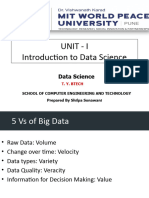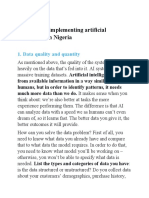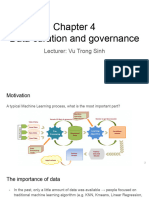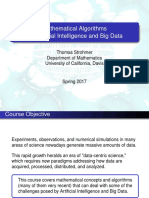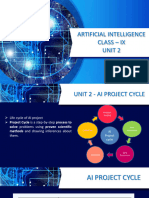Data and AI - Relationship
George Easaw
�Introduction to AI and Data
○ AI systems rely on data to learn and make
decisions.
○ The more accurate the data, the better the AI's
performance.
○ Relationship: Data is the "fuel" that powers AI.
�How AI Models Learn from Data
○ AI models use data to identify patterns and
trends.
○ Training vs. Testing Data: AI models learn from
training data and are tested on unseen data.
○ Importance of diverse and comprehensive
datasets for generalization.
�Types of Data in AI
○ Structured data: Organized, tabular data
(e.g., databases).
○ Unstructured data: Text, images, videos
(requires NLP, computer vision).
○ Labeled vs. Unlabeled data: Supervised vs.
unsupervised learning.
��Why Good Data is Necessary for Good AI
○ Garbage In, Garbage Out (GIGO): Poor data
leads to poor AI performance.
○ Accuracy and reliability: Clean, accurate
data results in better AI decisions.
○ Reducing bias: Diverse, well-balanced data
helps prevent biased outcomes.
�Data Quality and Its Impact on AI
○ Data quality factors: Completeness,
accuracy, timeliness, relevance.
○ Consequences of poor data: Inaccurate
predictions, biased decisions, system failures.
○ Importance of data preprocessing (cleaning,
normalizing, augmenting).
�The Feedback Loop Between AI and Data
○ AI models generate new data through user
interactions.
○ New data can be fed back into the system for
continuous learning and improvement.
○ Continuous learning: AI models evolve and
improve with more data.
��Big Data and AI
○ Big data has enabled AI to thrive by providing
large-scale datasets.
○ AI can process vast amounts of data to
uncover hidden insights.
○ Techniques like deep learning excel with big
data, improving accuracy.
��Challenges in Data for AI
○ Data privacy and security: Handling sensitive
data responsibly.
○ Data preprocessing: Real-world data requires
significant cleaning.
○ Data labeling: Labeled data for supervised
learning is labor-intensive.
�Conclusion
○ Good data is essential for building good AI
systems.
○ Quality, diversity, and relevance of data impact AI's
accuracy and fairness.
○ Organizations must prioritize data management for
AI success.
"To build great AI, we must first collect and manage
great data."


























